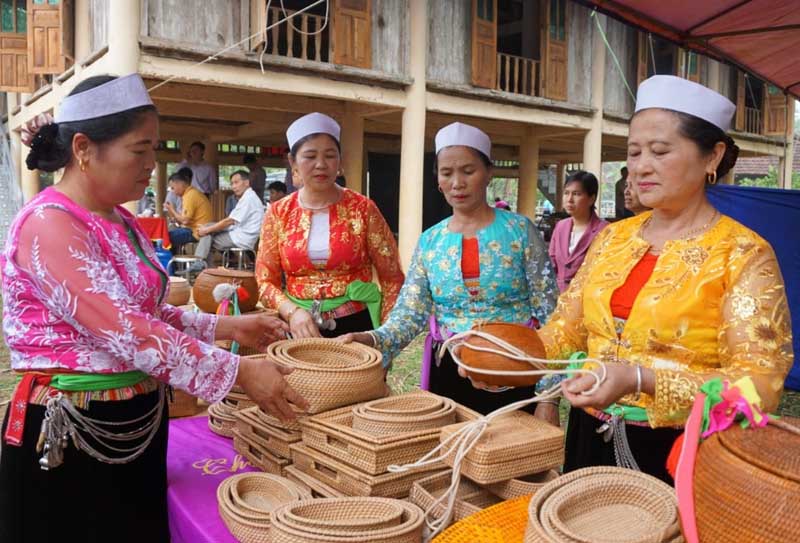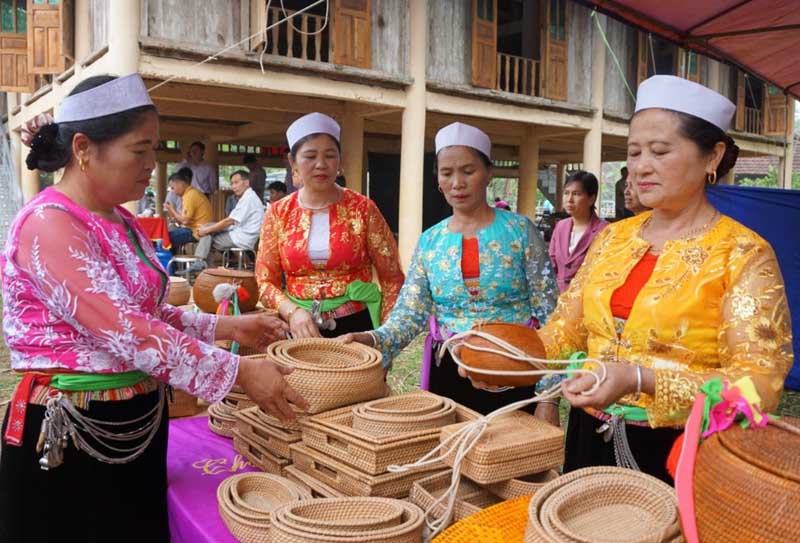
HBO – Lac Son district in Hoa Binh province now has two recognised traditional craft villages, namely the Luc brocade weaving village in Yen Nghiep commune (recognised in October 2013) and the Bui rattan and bamboo village in Nhan Nghia commune.
Rattan
and bamboo products of Bui village, Nhan Nghia commune (Lac Son district) win
favour of consumers.
The Luc brocade weaving village in Yen Nghiep commune includes three hamlets:
Luc 1, Luc 2 and Luc 3 with more than 200 looms run by 168 residents, most of
them women. Ms Bin, a villager, has joined hands with wholehearted weavers to
set up six brocade weaving groups in nearby communes such as Binh Chan, Da Phuc
and An Nghia, raising the total looms to 500.
Over 50,000 brocade items including dresses, shirts, caps and scarfs are turned
out annually, serving the demand of the people in the locality and surrounding
areas. The status of a traditional craft village has created a momentum for
women to attach themselves to the craft. In 2017, the cooperative was provided
with 300 million VND from the craft village support fund to buy three weaving
machines, one warping machine, three bobbin winders, five sewing machines and
146 looms. Each weaving machine has a daily capacity of 60m. In the past, a
productive weaver could turn out only 10m per day. Now, with a weaving machine,
the productivity is raised to 40m per day.
In April 2018, the Bui rattan and bamboo village in Nhan Nghia commune was
recognised as a traditional craft village. The craft has existed for long but
locals mainly made home utensils. Since 2000, it has developed widely with more
diverse designs. Many domestic and foreign tourists bought the village’s rattan
and bamboo products as souvenirs and home utensils. About 70 out of the 200
local households join the craft village, with 150 regular workers. Since its
recoginition, the craft village has generated jobs for over 300 labourers. Its
main products are flower vases, trays and baskets. They are sold at tourist
sites at home and abroad such as China, Japan and the Republic of Korea. With
its operation capital of 600 million VND, the village earns about 1.2 billion
VND per year in revenue and creates an average monthly income of 2.5 million
VND for each worker./.
With an increasingly vibrant and widespread emulation movement aimed at building cultured residential areas and cultured families, Yen Thuy District has been making steady progress toward improving both the material and spiritual well-being of its people, while fostering a civilized, prosperous, beautiful, and progressive community.
Once lacking recreational spaces and community facilities, Residential Group 2 in Quynh Lam Ward (Hoa Binh City) has recently received attention for the construction of a new, spacious, and fully equipped cultural house. The project followed the model of state support combined with public contributions in both labor and funding.
The "All people unite to build cultural life" movement, which has been effectively integrated with Kim Boi district’s socio-economic development goals, is fostering a lively spirit of emulation across local residential areas, hamlets, villages, public agencies, and enterprises. In addition, through the initiative, traditional cultural values are being preserved and promoted, while community solidarity and mutual support in poverty reduction and economic development are being strengthened.
A working delegation of the Hoa Binh provincial People’s Committee led by its Permanent Vice Chairman Nguyen Van Toan on June 11 inspected the progress of a project to build the Mo Muong Cultural Heritage Conservation Space linked to tourism services in Hop Phong commune, Cao Phong district.
Born and growing in the heroic land of Muong Dong, Dinh Thi Kieu Dung, a resident in Bo town of Kim Boi district, in her childhood was nurtured by the sweet lullabies of her grandmother and mother. These melodies deeply imprinted on her soul, becoming an inseparable part of her love for her ethnic group's culture. For over 20 years, this love for her hometown has driven Dung to research, collect, and pass down the cultural values of the Muong people to future generations.
In the final days of May, the Ethnic Art Troupe of Hoa Binh Province organized performances to serve the people in remote, mountainous, and particularly disadvantaged areas within the province. These were not just ordinary artistic shows, but they were the meaningful journeys aimed at spreading cultural values, enhancing the spiritual life of the people and contributing to the preservation of ethnic minority cultural identities.



